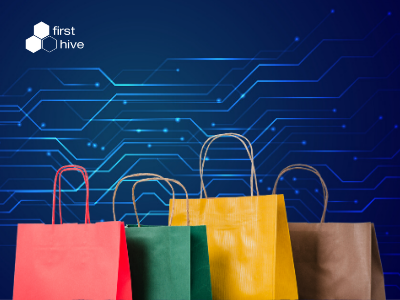Mobile App Personalization: 10 Ways to Convert and Retain App Users at Scale
June 4, 2020We live in an inter(net)-connected world where smartphone penetration, ever-improving mobile network infrastructure, and enhanced access to cheaper data are driving the app economy.
With over 2.7 billion smartphone users and 1.35 billion tablet users globally, there are 2.8 million apps on the Google Play Store and over 2.2 million apps on the Apple App Store. In fact, there were over 205 billion app downloads in 2019 alone.
That’s staggering!
Sure there’s a massive opportunity to empower users, strengthen your online presence, generate top-line revenues, and counter competition – but, that’s easier said than done.
One fool-proof way to consistently power user engagement, conversions, and retention at scale is by integrating a strong personalization strategy into your mobile (and omnichannel) marketing machinery.
And, personalization – today – has gone above and beyond the obvious. Addressing your users by their first names over a push notification or sending them a discount coupon on their birthdays over an email campaign is great.
But, it’s not enough! And, especially so in the current COVID-19 environment where hyper-competition for users’ screen-share, mindshare, and wallet-share has only heightened.
Your users expect and demand an end-to-end, tailor-made customer experience, right from first-time app launch. This assumes even greater significance across industries such as e-commerce, OTT, and news and media.
At Smartech, we understand how important 1:1 personalization is across platforms, channels, and devices to your omnichannel marketing efforts. And, with that in mind, we’ve bolstered our mobile app personalization module.
Here’s how you can now deliver highly differentiated user experiences at scale on and through your mobile app:
1. Build a solid foundation of and on user data:
Effective personalization is dependent on you gathering the right user data across channels and platforms. Gathering the right demographic, geolocation, and device-type data-points is important. Start capturing these basic data-points at the registration or login stage of your user onboarding flow.
But, you also need to capture your users’ in-app behaviors, actions, inactions, responses and interactions to multi-channel marketing campaigns. This will help you create and constantly enrich a unified view of every user, in real-time.
For instance, if you’re an e-commerce app, you need to log actions and details such as products searched, product categories browsed, products added to cart or wishlist, products purchased, payment mode chosen, and most common paths towards conversion.
If you have a physical store, you also need to ensure your transactional data is funnelling back into your data backend so as to personalize subsequent shopping experiences across both your website and/or app.
Simultaneously, you need to track relevant metrics attached to these actions to gather granular insights – recency and frequency of app launches and purchases, average time spent per screen, ratio of products added to cart and finally purchased, actual conversion rates, etc.
Analyzing these diverse data-points will help you gain actionable insights and develop relevant user segments.
Our AI engine, Raman, can actually help you dive deeper. Now slice and dice behavioral data to arrive at a segment of one, with AI doing all the heavy-lifting for you! Our cutting-edge collaborative and content-filtering algorithms make it possible for us to ingest large amounts of user data-points and behavioral footprints.
Raman also constantly learns from both clickstream and customer eyeball data; i.e. from both live actions and inactions that can be attributed to a user.
That’s not it, though! We also help you map and leverage data-points such as device price and brand of device to further fortify device-related information.
Once you have your user data and analytics backbone in place, you can focus on adding muscle to your personalization strategy.
2. Personalize the app home screen on first-time launch:
Modern marketing has driven home the fact that one size doesn’t fit all. Depending upon your app category and the quality (and quantity) of demographic data-points that you’re able to gather during the first-time onboarding flow – you can immediately start delivering a personalized user experience on your app homepage.
For instance: If you are an OTT music streaming app; data-points like name, age, gender, preferred genres and languages, favorite artists, etc. can be used to curate a first-degree personalized list of content recommendations on your app home screen instantly.
You need to strike the right balance between deploying an onboarding flow that educates new users on functionality, key features, etc. and capturing relevant demographic data-points (without being explicitly intrusive) to start delivering 1:1 user experiences ASAP.
Notice how Hungama Music, one of India’s leading home-grown music streaming apps, does this during the user onboarding process to quickly begin personalizing content recommendations when the home screen launches for the first time.
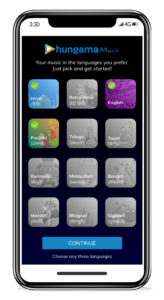
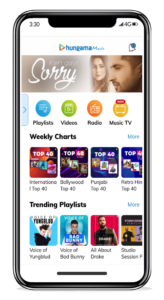
You can subsequently highlight the most relevant recommendations on the app home screen on future app launches. This can increase your CTRs by 90-120% while uplifting content consumption by 5-7%!
3. Tailor-make the app navigation experience:
Apart from your users’ search, browsing, click behaviour and consumption history, you can personalize how your users navigate across your mobile app.
Other parameters such as gender, buyer personas, geolocation, time of day/timezone, seasons/weather, etc. can be harnessed to personalize the banner images, graphics, CTAs, trending products and offers, etc.
Also, leverage insights from your users’ most common paths towards conversion to further optimize their navigation journey. The more individualized the navigation journey, greater the probability of your users finding exactly what they want, faster!
Check out how AJIO, a leading e-commerce clothing retailer offers a gender-based app navigation experience for both men and women.
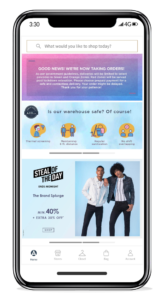
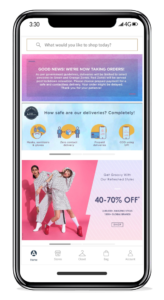
4. Personalize the search experience:
Any search made by a user on your app is a solid signal of intent. Intent to purchase a product. Intent to book a ticket. Intent to consume content. And, you need to value these search inputs.
Every search action undertaken by specific users tells you about their instant wants, needs, and preferences. And, your objective must be to direct your users to exactly what they want faster.
With the assistance of our AI engine, Raman, you can now instantly populate product or content recommendations based on the partial or full search terms inputted in the search tab. This would also take into account historical searches made.
These recommendations continue to get more accurate with each subsequent search action that a user takes, helping you to significantly reduce the path from product discovery to purchase.
For instance: As an e-commerce platform that specializes in the online retail of cosmetics, you can start giving the most relevant product recommendations for lipsticks when a user is searching for a particular brand of lipsticks.
Here’s how Amazon leverages search personalization to show me sub-product categories that are most relevant to me.
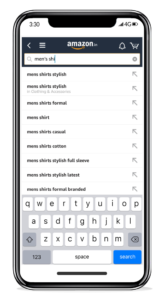
5. Showcase real-time AI-led predictive recommendations:
Falling user attention spans and quick access to alternate apps in the same category can fuel switching behavior. This is why you need to respect the time an individual user potentially invests when he/she launches your app. Near-instant product discovery and top-of-sight visibility become critical to conversions or consumption.
Our AI engine, Raman, enables you to show the most relevant product or content recommendations across your Home Screen, Product Display Screen, and Product Listing Screen.
Much like our existing onsite dynamic personalization for websites, you can replicate the same for your mobile app. These live recommendations are optimized for mobile display and click, ensuring that you maximize the use of screen-space on every scroll.
Moreover, these recommendations get more refined with each shopping session that an individual user engages in.
Not only does our AI engine account for clickstream data, but it also accounts for customer eyeball data. This implies that negative signals for any product or content recommendations that are “seen-and-not clicked” and “not seen-and-not clicked” feed right back into the AI engine – all in real-time.
This helps you improve behavioral predictions by almost 20%.
6. Re-order product or content categories for greater context:
If you have an e-commerce, OTT, or news and media app; you are bound to have hundreds of products or content options within your product catalog or content library.
Our patented AI algorithms can re-order these categories in real-time for individual users so the most relevant product or content recommendations show up right at the top.
Remember the Golden Rule?
Near-instant product discovery and top-of-sight visibility become critical to conversions or consumption!
In the below example, our AI engine can actually re-order listed product categories to show the most relevant categories from top to bottom, to individual users in real-time.
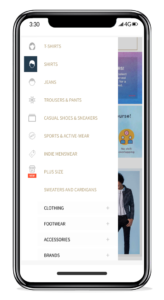
7. Create an in-app personalized storefront or playlist:
Go one step further and allow Raman to specially curate a mobile boutique – composed of only those products or content recommendations that an individual user is most likely to view, buy, or consume on your app!
Delight your users with a unique online shopping or content consumption experience while increasing CTRs by 120-150%, every time they launch your app.
Neural networks bolster Raman’s real-time, reinforced learning capacity; as it refreshes the list of recommendations every time a user chooses to launch the personalized storefront, watch-list, playlist, or read-list.
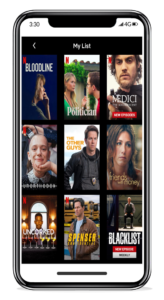
Netflix curates a personalized watch-list for each subscribed user that is refined and refreshed after each active session on their app or website.
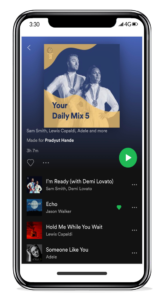
Spotify actually goes a step further to create multiple weekly playlists based on preferred genres, favorite artists, and music language.
8. Deploy live contextual recommendations via in-app messages:
You can optimize your in-app personalization strategy by triggering relevant product or content recommendations and appropriate offers at individual users through in-app messages.
These can be triggered when a user lands on certain pre-defined screens or when a user scrolls a finite percentage on certain pre-defined screens.
Our AI engine, Raman, intelligently triggers these in-app messages only when they truly make sense, without disrupting the ongoing user experience.
For instance: As an e-commerce app that has a health and hygiene product category, if a user has added hand sanitizers to his/her cart, you can trigger a relevant recommendation for facemasks and hand-washes, as a dynamic product bundle.
Such a strategy can also help you increase your average order value through effective cross-sell and upsell opportunities.
9. Personalize your recommendations across other channels:
While personalizing the entire in-app mobile experience is important, what do you do when your user is not in an active session? You can’t leave that to chance.
The essence of personalization lies in delivering a rich and unique 1:1 user experience across multiple digital touchpoints. This implies that you need to activate other critical mobile marketing channels such as emails and app push notifications to continue delivering these personalized recommendations.
With Smartech, you can now trigger laser-focused product recommendations across these channels to maintain top-of-mind recall, bring inactive users back to your app, and potentially nudge them towards a conversion event.
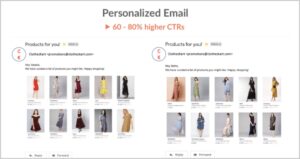
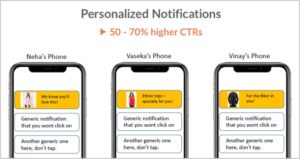
Here are the kind of contextual recommendations that you can deliver to pursue conversions beyond just your mobile app, especially in the e-commerce space:
- “Suggested for You” Recommendations: These are the best possible recommendations tailored to individual users based on their general historical behaviour; i.e. product/product categories viewed, items added to cart, purchase, etc.
- “Cart Abandonment” Recommendations: These are generated based on the products added to an individual user’s digital shopping carts where the user may have dropped-off or left a purchase incomplete.
- Buying Pattern Recommendations: These are generated based on an individual user’s most recent product purchases.
For instance: If you identify a user segment that has repeatedly purchased Washing Detergent and Fabric Softeners and these out of stock due to a demand surge – you can trigger personalized app push recommendations updating this segment when these products are back in stock. - Viewing Pattern Recommendations: These are triggered based on an individual user’s most recent products or product categories viewed.
- Bestselling Recommendations: These are generated based on the highest selling products on your mobile app. These are products that are being purchased the most when compared to other products over a period of time.
For instance: In the current scenario, health safety and hygiene products such as facemasks, disinfectants, and hand sanitizers have quickly become bestselling products – over the last 2 months – and will see a steady demand even when the lockdown period is relaxed. - Trending Recommendations: These are generated based on the most trending products on your mobile app. Essentially, these are products whose consumption has shown a percentage increase over a period of time.
For instance: Building on the above example, health safety and hygiene products like facemasks rapidly became a trending product within its category and very soon emerged as a bestselling product, as the COVID-19 turned into a pandemic. - Recently Viewed Recommendations: These are generated based on the most common products that have been recently viewed by individual users on your mobile app.
- “New Arrival” Recommendations: These are generated based on the new products that have been added to your product catalog. Our AI engine, Raman, maps these products to the ones that are most relevant to individual users and displays the ideal recommendations, capable of nudging him/her towards an eventual purchase.
Depending upon what channels of customer engagement are working best for which customer segments and buyer personas, you can optimize your multi-channel mix, as well as the send-times for these recommendation campaigns.
Raman evaluates the real-time performance of these triggered recommendations for relevant user segments to offer you deep-dive insights on the preferred channels and send-times that are likely to produce the best engagement and conversion rates.
10. Re-target existing users with personalized ads:
Regardless of your best efforts at encouraging your users to make a purchase or spend more time consuming content on your app, there will be drop-offs and users that straddle dormancy.
That’s the harsh reality of mobile marketing!
But, our AI engine, Raman, can actually target individual users with the most relevant product or content recommendations through optimized re-targeting ads across Google, Facebook, and Instagram – at the right time.
For instance: As an e-commerce app specializing in fashion apparel, you can re-target existing users with the most relevant t-shirt, shirt, or trouser related recommendations that are most contextual to individual male users. Depending upon where a user is most likely to see this ad, Raman will display a mobile-optimized ad, nudging the user to click and re-launch your app.
Personalization at Scale = Stickier 1:1 Experiences = User Retention

Mobile app personalization is not a set-it-and-forget-it project. While our AI engine, Raman, will help you deliver relevant recommendation-led 1:1 user experiences; human intelligence also plays an important role. When AI and human intelligence comes together, you can continue to optimize experiences for a segment of one!
Also, remember that mobile app personalization is another weapon in your larger omnichannel personalization arsenal. Wowing your users just on one platform is not going to cut it! They expect a consistent and frictionless experience across your website, mobile app, and marketing channels (across devices).
To learn how you can get started on your mobile app personalization journey – with AI as your sidekick – like the giants in the industry do; get in touch with our growth experts today!
[P.S. Hang on. We’ve got something special in store for you! We understand that it may not be business as usual for you currently.

